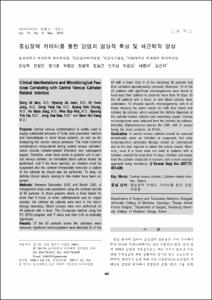중심정맥 카테터를 통한 감염의 임상적 특성 및 세균학적 양상
- Keimyung Author(s)
- Kang, Sun Hee
- Department
- Dept. of Surgery (외과학)
- Journal Title
- 대한외과학회지
- Issued Date
- 2007
- Volume
- 72
- Issue
- 5
- Abstract
- Purpose: Central venous catheterization is widely used to supply substantial amounts of fluids, total parenteral nutrition and hemodialysis in renal failure patients, as well as for measuring the central venous pressure. The most common complications encountered during central venous catheterization include catheter-related infections and subsequent sepsis. Therefore, when fever exists in patients with a central venous catheter, an immediate blood culture should be performed, and if the fever persists, an infection must be suspected and the catheter immediately removed; a culture of the catheter tip should also be performed. To date, no definite clinical details relating to this matter have been reported.
Methods: Between December 2002 and March 2005, a retrospective study was undertaken using the medical records of 85 patients. In those patients where a fever lasted for more than 8 hours, or when catheterization was no longer needed, the catheter tip cultures were sent to the microbiology laboratory. Blood cultures were also performed on 49 patients with a fever. The Chi-square method using the PC SPSS program, with P value less than 0.05 as statically significant.
Results: Of the 85 patients where the catheters were removed, significant microorganisms were detected 20 of the 49 with a fever. Only 5 of the remaining 36 patients had their catheters spontaneously removed. Moreover, 14 of the 20 patients with significant microorganisms were found to have kept their catheter in place for more than 14 days. Of the 49 patients with a fever, in who blood cultures were undertaken, 13 showed specific microorganisms, with 6 of these showing the same results for both their blood and catheter tip cultures, which enabled the definite diagnosis of the catheter-related infection and underlying sepsis. Various microorganisms were detected from the catheter tip cultures, including Staphylococcus species the CNS, with S. aureus being the most common, at 61.6%.
Conclusion: A central venous catheter should be removed immediately when an infection is suspected, but early broad-spectrum antibiotics therapy should be commenced due to the time required to obtain the culture results. Moreover, even if a fever does not exist in patients with a catheter inserted for more than 14 days, infection and sepsis from the catheter should be of concern, with a more cautious approach being mandatory.
- Alternative Title
- Clinical Manifestations and Microbiological Features Correlating with Central Venous Catheter Related Infection
- Keimyung Author(s)(Kor)
- 강선희
- Publisher
- School of Medicine
- Citation
- 문성욱 et al. (2007). 중심정맥 카테터를 통한 감염의 임상적 특성 및 세균학적 양상. 대한외과학회지, 72(5), 403–408.
- Type
- Article
- ISSN
- 1226-0053
- Appears in Collections:
- 1. School of Medicine (의과대학) > Dept. of Surgery (외과학)
- 파일 목록
-
-
Download
 oak-bbb-03000.pdf
기타 데이터 / 198.77 kB / Adobe PDF
oak-bbb-03000.pdf
기타 데이터 / 198.77 kB / Adobe PDF
-
Items in Repository are protected by copyright, with all rights reserved, unless otherwise indicated.